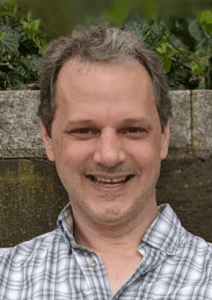Posted By: Sara Cullinan, PhD, Deputy Editor, AJHG
Each month, the editors of The American Journal of Human Genetics interview an author of a recently published paper. This month we check in with Andrew to discuss his paper “A phenome-wide association study identifies effects of copy-number variation of VNTRs and multicopy genes on multiple human traits.”

SC: What motivated you to start working on this project?
AS: I’ve been interested in wacky bits of the genome for a long time. I actually remember way back in 2004 when as a postdoc with Evan Eichler we first started getting data from early array CGH experiments using BAC arrays that included duplicated bits of the genome. I clearly remember one day scrolling through the data, and stumbling across these really striking repeated patterns you could see in the profiles we were getting where it was clear that certain regions of the genome had highly variable copy numbers even in our control samples. At that time, there was a general idea that the genome was this very static thing and that every gene is always present in two copies in normal people. So, the idea that there were these big repeats with genes in them that were varying wildly in copy number in the general population really stuck in my head, and I thought, these things have to be doing something important, and wouldn’t it be neat to start looking at these things and figuring out what they do?
SC: What about this paper/project most excites you?
AS: That after 18 years I’ve finally managed to start answering that question! It’s really nice to see an idea that I had way back then actually come to fruition at last. A lot of the reason this took so long has been dependent on many other factors outside my lab and general developments in the field, like big consortia generating sequencing data from tens of thousands of samples, making these data freely available to others, and cloud computing that enables us to access and analyze these data in a scalable fashion. So, it’s not like I’ve spent the last 18 years of my life working on this, but rather it was just a question that had to wait for the right moment before we could start to answer it. Once all those parts fell into place, all we had to do was figure out the right methods to actually be able to characterize these big tandem repeats from Illumina sequencing data.
SC: Thinking about the bigger picture, what implications do you see from this work for the larger human genetics community?
AS: For the past 20 years, a lot of people in the human genetics community have focused on SNPs and doing GWAS, and there is this idea that if we just look at big enough sample sizes, we’ll be able to figure out all the important genetics of a condition. But there’s always been this observation that even if you add up all the SNPs found in really well powered GWAS, they never explain all the heritability of a disease. For a long time, people have been saying, maybe complex regions and tandem repeats and bits of the genome that are missing from SNP arrays might fill in some of that missing heritability? I think this study really underlines that idea, and shows there is a whole world of genetic variation beyond SNPs that is simply thrown out by most standard genomics pipelines. Sometimes it pays to not just follow the herd.
SC: What advice do you have for trainees/young scientists?
AS: Follow your curiosity and find a good mentor and lab where you will do interesting science that excites you. Enjoy the relative time and freedom you have when you are a trainee, because once you start moving up, time becomes your most precious resource. And no matter how much you like doing science, don’t spend too much time in the lab.
SC: And for fun, tell us something about your life outside of the lab.
AS: I have a three year-old daughter who takes up a lot of my time. But where possible, I love to cook, and it’s a lot of fun introducing her to new foods and how to make them. So, besides hanging out at the local playgrounds, on a weekend we often bake cakes together (though she recently confessed that she only likes doing it because she gets to lick the bowl afterwards).
